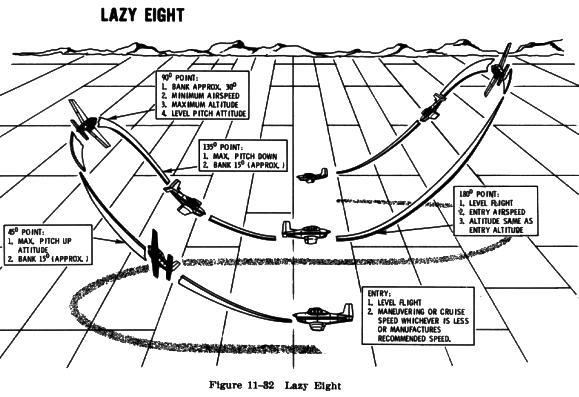| Lazy 8
This maneuver derives its name from the manner in which the extended longitudinal axis of the airplane is made to trace a flight pattern in the form of a figure 8 lying on its side (a "Lazy" 8) (Fig. 11-32). Objective of the Lazy 8 is to develop the pilot's feel for varying control forces, and the ability to plan and remain oriented while maneuvering the airplane with positive, accurate control. It requires constantly changing control pressures necessitated by changing combinations of climbing and descending turns at varying airspeeds. This is a maneuver often used to develop and demonstrate the pilot's mastery of the airplane in maximum performance flight situations. 
A "Lazy 8" consists of two 180 degree turns, in opposite directions, while making a climb and a descent in a symmetrical pattern during each of the turns. At no time throughout the Lazy 8 is the airplane flown straight and level; instead, it is rolled directly from one bank to the other with the wings level only at the moment the turn is reversed at the completion of each 180 degree change in heading. As an aid to making symmetrical loops of the 8 during each turn, prominent reference points should be selected on the horizon. The reference points selected should be 45 degrees, 90 degrees, and 135 degrees from the direction in which the maneuver is begun. Prior to performing a Lazy 8, the airspace behind and above should be clear of other air traffic. The maneuver should be entered from straight and level flight at normal cruise power and at the airspeed recommended by the manufacturer or at the airplanes design maneuvering speed. The maneuver is started from level flight with a gradual climbing turn in the direction of the 45 degree reference point. The climbing turn should be planned and controlled so that the maximum pitch up attitude is reached at the 45 degree point. The rate of rolling into the bank must be such as to prevent the rate of turn from becoming too rapid. As the pitch attitude is raised the airspeed decreases, causing the rate of turn to increase. Since the bank also is being increased, it too causes the rate of turn to increase. Unless the maneuver is begun with a slow rate of roll, the combination of increasing pitch and increasing bank will cause the rate of turn to be so rapid that the 45 degree reference point will be reached before the highest pitch attitude is attained. At the 45 degree point, the pitch attitude should be at maximum and the angle of bank continuing to increase. Also, at the 45 degree point, the pitch attitude should start to decrease slowly toward the horizon and the 90 degree reference point. Since the airspeed is still decreasing, right rudder pressure will have to be applied to counteract torque. As the airplane's nose is being lowered toward the 90 degree reference point, the bank should continue to increase. Due to the decreasing airspeed, a slight amount of opposite aileron pressure may be required to prevent the bank from becoming too steep. When the airplane completes 90 degrees of the turn, the bank should be at the maximum angle (approximately 30 degrees), the airspeed should be at its minimum (5 to 10 knots above stall speed), and the airplane pitch attitude should be passing through level flight. It is at this time that an imaginary line, extending from the pilot's eye and parallel to the longitudinal axis of the airplane, passes through the 90 degree reference point. Lazy 8's normally should be performed with no more than approximately a 30 degree bank. Steeper banks may be used but control touch and technique must be developed to a much higher degree than when the maneuver is performed with a shallower bank. The pilot should not hesitate at this point but should continue to fly the airplane into a descending turn so that the airplane's nose describes the same size loop below the horizon as it did above. As the pilot's reference line passes through the 90 degree point, the bank should be decreased gradually, and the airplane's nose allowed to continue lowering. When the airplane has turned 135 degrees, the nose should be in its lowest pitch attitude. The airspeed will be increasing during this descending turn so it will be necessary to gradually relax rudder and aileron pressure and to simultaneously raise the nose and roll the wings level. As this is being accomplished, the pilot should note the amount of turn remaining and adjust the rate of rollout and pitch change so that the wings become level and the original airspeed is attained in level flight just as the 180 degree point is reached. Upon reaching that point, a climbing turn should be started immediately in the opposite direction toward the selected reference points to complete the second half of the eight in the same manner as the first half. Due to the decreasing airspeed considerable right rudder pressure must be gradually applied to counteract torque at the top of the eight in both the right and left turns. The pressure will be greatest at the point of lowest airspeed. More right rudder pressure will be needed during the climbing turn to the right than in the turn to the left because more torque correction is needed to prevent yaw from decreasing the rate of turn. In the left climbing turn the torque will tend to contribute to the turn; consequently, less rudder pressure is needed. It will be noted that the controls are slightly crossed in the right climbing turn because of the need for left aileron pressure to prevent over banking and right rudder to overcome torque. The correct power setting for the lazy eight is that which will
maintain the altitude for the maximum and minimum airspeeds used during the
climbs and descents of the eight. Obviously, if excess power were used, the
airplane would have gained altitude when the maneuver is completed, while if
insufficient power were used, altitude would have been lost.
|
